
Cypripedioideae is a subfamily of orchids commonly known as lady's slipper orchids, lady slipper orchids or slipper orchids. Cypripedioideae includes the genera Cypripedium, Mexipedium, Paphiopedilum, Phragmipedium and Selenipedium. They are characterised by the slipper-shaped pouches of the flowers – the pouch traps insects so they are forced to climb up past the staminode, behind which they collect or deposit pollinia, thus fertilizing the flower. There are approximately 165 species in the subfamily.

Cypripedium is a genus of 58 species and nothospecies of hardy orchids; it is one of five genera that together compose the subfamily of lady's slipper orchids (Cypripedioideae). They are widespread across much of the Northern Hemisphere, including most of Europe and Africa (Algeria), Russia, China, Central Asia, Canada the United States, Mexico, and Central America. They are most commonly known as slipper orchids, lady's slipper orchids, or ladyslippers; other common names include moccasin flower, camel's foot, squirrel foot, steeple cap, Venus' shoes, and whippoorwill shoe. An abbreviation used in trade journals is "Cyp." The genus name is derived from Ancient Greek Κύπρις (Kúpris), an early reference in Greek myth to Aphrodite, and πέδιλον (pédilon), meaning "sandal".

Calypso is a genus of orchids containing one species, Calypso bulbosa, known as the calypso orchid, fairy slipper or Venus's slipper. It is a perennial member of the orchid family found in undisturbed northern and montane forests. It has a small pink, purple, pinkish-purple, or red flower accented with a white lip, darker purple spottings, and yellow beard. The genus Calypso takes its name from the Greek signifying concealment, as they tend to favor sheltered areas on conifer forest floors. The specific epithet, bulbosa, refers to the bulb-like corms.

Halictidae is the second-largest family of bees with nearly 4,500 species. Halictid species are an extremely diverse group that can vary greatly in appearance. These bees occur all over the world and are found on every continent except Antarctica. Usually dark-colored and often metallic, halictids are found in various sizes, colors and patterns. Several species are all or partly green and a few are red, purple, or blue. A number of them have yellow markings, especially the males, which commonly have yellow faces, a pattern widespread among the various families of bees. The family is one of many with short tongues and is best distinguished by the arcuate basal vein found on the wing. Females in this family tend to be larger than the males.

Henry Harpur-Crewe (1828–1883) was an English clergyman and naturalist. From 1856 to 1860 he was the Curate of Drinkstone and Creeting St Peter, both in Suffolk, but in 1860 he was appointed Rector of Drayton Beauchamp, a living he occupied until his death in 1883.

The Malá Fatra National Park is a national park in the northern part of the Malá Fatra mountains called Krivánska Malá Fatra.

The genus Halictus is a large assemblage of bee species in the family Halictidae. The genus is divided into 15 subgenera, some of dubious monophyly, containing over 200 species, primarily in the Northern Hemisphere. Most species are black or dark brown, sometimes metallic greenish-tinted, with apical whitish abdominal bands on the terga.

Cypripedium candidum, known as the small white lady's slipper or white lady's slipper, is a rare orchid of the genus Cypripedium. It is native to eastern North America across the northern United States and southern Canada.
Yellow lady's-slipper may refer to any of three yellow orchids from the genus Cypripedium:
Paljakka Strict Nature Reserve is a strict nature reserve located in the Kainuu region of Finland. It consists of old, high spruce forest, where the highest trees can reach 40 metres (130 ft). Finland's only orchid species, Cypripedium calceolus, grows in the Paljakka reserve.
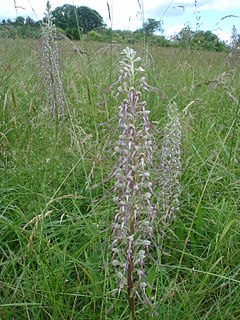
The Jardin botanique du col de Saverne, also known as the Jardin botanique de Saverne, is a botanical garden and arboretum located along the Col de Saverne near Saverne, Bas-Rhin, Alsace, France. It is open on weekends, and daily in the warmer months; an admission fee is charged.
The Trudner Horn Nature Park is a nature reserve south of Bolzano in South Tyrol, Italy.

Cypripedium reginae, known as the showy lady's slipper, pink-and-white lady's-slipper, or the queen's lady's-slipper, is a rare lady's-slipper orchid native to northern North America. Although never common, this plant has vanished from much of its historical range due to habitat loss. It is the state flower of Minnesota.
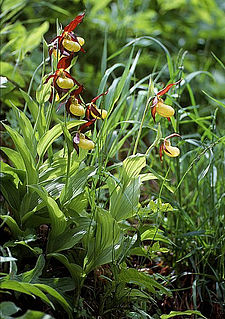
Cypripedium calceolus is a lady's-slipper orchid, and the type species of the genus Cypripedium. It is native to Europe and Asia.
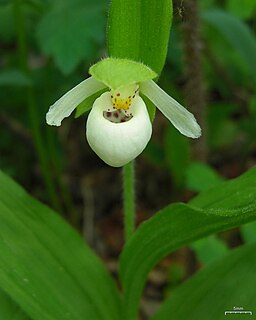
Cypripedium passerinum is a species of lady's slipper orchid known by the common names sparrow's-egg lady's-slipper, spotted lady's-slipper, and Franklin's lady's-slipper.
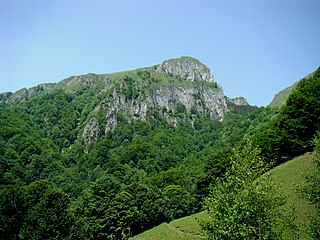
The Buila-Vânturarița National Park is a protected area situated in Romania, in the central-northern part of Vâlcea County, in the administrative territory of the localities Costești, Bărbătești, and Băile Olănești.

Puhtu-Laelatu Nature Reserve is a nature reserve situated in western Estonia, in Lääne County. It is located in the territory of Pivarootsi, Rame and Hanila villages and in Virtsu small borough.

Halictus confusus, the southern bronze furrow bee or confused sweat bee, is a species of sweat bee in the family Halictidae. It is a primitively eusocial bee species found in open habitats in Eurasia and North America.
Halictus hotoni, Hoton's metallic-furrow bee, is a species of sweat bee in the family Halictidae native to southern Africa and introduced to Australia. It was initially identified as the Emerald metallic-furrow bee It was described by Joseph Vachal in 1903.
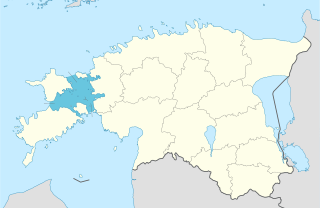
The Väinameri Conservation Area is a protected area in Estonia.
















